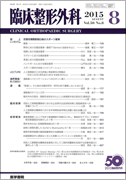1) Aach M, Cruciger O, Sczesny-Kaiser M, et al:Voluntary driven exoskeleton as a new tool for rehabilitation in chronic spinal cord injury:a pilot study. Spine J 14:2847-2853, 2014
2) Banala SK, Kim SH, Agrawal SK, et al:Robot assisted gait training with active leg exoskeleton (ALEX). IEEE Trans Neural Syst Rehabil Eng 17:2-8, 2009
3) Bovolenta F, Goldoni M, Clerici P, et al:Robot therapy for functional recovery of the upper limbs:a pilot study on patients after stroke. J Rehabil Med 41:971-975, 2009
4) Burgar CG, Lum PS, Shor PC, et al:Development of robots for rehabilitation therapy:the Palo Alto VA/Stanford experience. J Rehabil Res Dev 37:663-673, 2000
5) Calabrò RS, Reitano S, Leo A, et al:Can robot-assisted movement training (Lokomat) improve functional recovery and psychological well-being in chronic stroke? Promising findings from a case study. Funct Neurol 29:139-141, 2014
6) Capó-Lugo CE, Mullens CH, Brown DA:Maximum walking speeds obtained using treadmill and overground robot system in persons with post-stroke hemiplegia. J Neuroeng Rehabil 9:80, 2012
7) Dal Farra F, Boem D, Magni S, et al:Efficacy of the Regent Suit training during a post-acute stroke rehabilitation process:description of a case report. G Ital Med Lav Ergon 33:74-83, 2011
8) 福田宏幸,濱田緒美,緒方利安・他:スーツHALの急性期リハビリテーション適応に関する研究−HAL訓練施行前後のアンケート調査分析.臨床と研究90:145-150,2013
9) Gandolfi M, Formaggio E, Geroin C, et al:Electroencephalographic changes of brain oscillatory activity after upper limb somatic sensation training in a patient with somatosensory deficit after stroke. Clin EEG Neurosci 2014 Sep 2.pii:1550059414536895
10) 濱田緒美,大川将和,緒方利安・他:ロボットスーツHALを用いた脳卒中超急性期リハビリテーションの適応と安全性について.臨床と研究89:136-141,2012
11) 濱田緒美,上羽哲也,緒方利安・他:脳卒中超急性期リハビリテーションにおいて,ロボットスーツHALの使用が麻痺側生体電位検出に有効であった1例.脳外誌22:792-797,2013
12) Hesse S, Uhlenbrock D:A mechanized gait trainer for restoration of gait. J Rehabil Res Dev 37:701-708, 2000
13) Hesse S, Schmidt H, Werner C, et al:Upper and lower extremity robotic devices for rehabilitation and for studying motor control. Curr Opin Neurol 16:705-710, 2003
14) Kawamoto H, Kamibayashi K, Nakata Y, et al:Pilot study of locomotion improvement using hybrid assistive limb in chronic stroke patients. BMC Neurol 13:141, 2013
15) Krebs HI, Hogan N, Aisen ML, et al:Robot-aided neurorehabilitation. IEEE Trans Rehabil Eng 6:75-87, 1998
16) Kubota S, Nakata Y, Eguchi K, et al:Feasibility of rehabilitation training with a newly developed wearable robot for patients with limited mobility. Arch Phys Med Rehabil 94:1080-1087, 2013
17) Maeshima S, Osawa A, Nishio D, et al:Efficacy of a hybrid assistive limb in post-stroke hemiplegic patients:a preliminary report. BMC Neurol 11:116, 2011
18) Masiero S, Armani M, Rosati G:Upper-limb robot-assisted therapy in rehabilitation of acute stroke patients:focused review and results of new randomized controlled trial. J Rehabil Res Dev 48:355-366, 2011
19) Muramatsu Y, Umehara H, Kobayashi H:Improvement and quantitative performance estimation of the back support muscle suit. Conf Proc IEEE Eng Med Biol Soc. 2013;2013:2844-2849.
20) Nilsson A, Vreede KS, Häglund V, et al:Gait training early after stroke with a new exoskeleton-the hybrid assistive limb:a study of safety and feasibility. J Neuroeng Rehabil 11:92, 2014
21) Patton J, Brown DA, Peshkin M, et al:KineAssist:design and development of a robotic overground gait and balance therapy device. Top Stroke Rehabil 15:131-139, 2008
22) Picelli A, Tamburin S, Passuello M, et al:Robot-assisted arm training in patients with Parkinson's disease:a pilot study. J Neuroeng Rehabil 11:28, 2014
23) Reinkensmeyer DJ, Kahn LE, Averbuch M, et al:Understanding and treating arm movement impairment after chronic brain injury:progress with the ARM guide. J Rehabil Res Dev 37:653-662, 2000
24) Song WK, Song WJ, Kim Y, et al:Usability test of KNRC self-feeding robot. IEEE Int Conf Rehabil Robot. 2013 Jun;2013:6650501.doi:10.1109/ICORR.2013.665050/
25) Tanabe S, Hirano S, Saitoh E:Wearable Power-Assist Locomotor (WPAL) for supporting upright walking in persons with paraplegia. NeuroRehabilitation 33:99-106, 2013
26) Tomelleri C, Waldner A, Werner C, et al:Adaptive locomotor training on an end-effector gait robot:evaluation of the ground reaction forces in different training conditions. IEEE Int Conf Rehabil Robot 2011;2011:5975492
27) Ueba T, Hamada O, Ogata T, et al:Feasibility and safety of acute phase rehabilitation after stroke using the hybrid assistive limb robot suit. Neurol Med Chir (Tokyo) 53:287-290, 2013
28) Veneman JF, Kruidhof R, Hekman EE, et al:Design and evaluation of the LOPES exoskeleton robot for interactive gait rehabilitation. IEEE Trans Neural Syst Rehabil Eng 15:379-386, 2007

